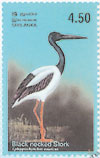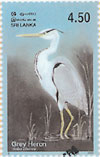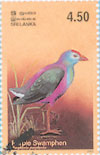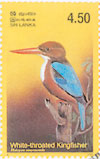|
Stamp
News 255 by Uncle Dee Cee The stamps featured a Grackle (selalihiniya), a peacock (monara), a jungle fowl (vali kukula) and an oriole (kahakurulla). “Amongst the wonderful gifts of nature are beautiful birds in colourful natural sanctuaries”, the caption in the souvenir sheet read. The most recent issue of bird stamps was on 27 September 2003 when a set of 25 ‘Resident Birds of Sri Lanka’ was released. They were divided into five categories. Let us discuss the first of the five sets - ‘Water associated birds’. Their association with water relates to living or moving about in water, and those looking for their prey in water. These birds in turn fall into four sections.
Among the water associated birds is the Black-necked Stork (‘Manawa’ in Sinhala) - the tallest bird species in the Island. Not many of them exist. A recent survey could record just 12-17 birds at the Ruhunu National Park. A few have been noticed in the Western coast. These very rare birds are seen in the marshes, rivers, tanks and lagoons in the lowland dry zone. The Purple Swamp-Hen (Podu dam Kithala) gets out in the evening to pick their food having spent the day in dense reed beds. They can be seen in pairs during feeding time. The Grey Heron (Alu Koka) is a solitary bird that defends its territory. They nest in colonies and the breeding season is from December to April. The nest is made up of a large mass of sticks placed among the branches of a tree. It is a common bird seen all over in the low country. The White-throated Kingfisher (Laya sud-medi Pilihuduwa) is a very common and abundant kingfisher species. It can frequently be seen hunting adjacent to bodies of water located in grounds, roadsides and gardens. It swings its body and tail up and down while uttering a cry.
A characteristic
feature is the performance of a breeding dance during the breeding
season, which is from December to March. The nest is an untidy mass
of sticks. It is also common throughout the low country. |
||||
Copyright © 2001 Wijeya Newspapers
Ltd. All rights reserved. |
 Birds
of Sri Lanka have been featured in stamps from time to time. Although
the first set of pictorial stamps were issued as early as 1935,
it was not until 1966 that birds were featured on stamps. On 5 February
1966 a set of four stamps was released in a colourful souvenir sheet
under the title ‘Typical Birds of Ceylon’.
Birds
of Sri Lanka have been featured in stamps from time to time. Although
the first set of pictorial stamps were issued as early as 1935,
it was not until 1966 that birds were featured on stamps. On 5 February
1966 a set of four stamps was released in a colourful souvenir sheet
under the title ‘Typical Birds of Ceylon’.  There
are those who find the meals either while swimming or by diving.
Others roam about in the sky and dive no sooner they spot a prey.
Birds with long limbs get about in water or look for food walking
about on the bunds. There are yet others who find their meals by
walking about in wetland.
There
are those who find the meals either while swimming or by diving.
Others roam about in the sky and dive no sooner they spot a prey.
Birds with long limbs get about in water or look for food walking
about on the bunds. There are yet others who find their meals by
walking about in wetland. For
breeding which takes place in the first half of the year, the nest
is made up of a large heap of rushes and sedges, hollowed out at
the top. It is placed on a reed bed or on the ground. The bird is
commonly seen in the low country dense reed beds, swamps or abandoned
fields.
For
breeding which takes place in the first half of the year, the nest
is made up of a large heap of rushes and sedges, hollowed out at
the top. It is placed on a reed bed or on the ground. The bird is
commonly seen in the low country dense reed beds, swamps or abandoned
fields. The
breeding season extends from December to June. It is resident in
all parts of the country and can be seen in gardens, towns, paddy
fields and open bodies of water. The Black-crowned Night Heron (Re
Koka), as the name suggests, is a night bird spending the day roosting
in colonies. At dusk it flies out looking for food.
The
breeding season extends from December to June. It is resident in
all parts of the country and can be seen in gardens, towns, paddy
fields and open bodies of water. The Black-crowned Night Heron (Re
Koka), as the name suggests, is a night bird spending the day roosting
in colonies. At dusk it flies out looking for food.